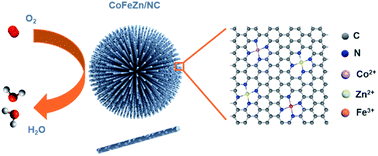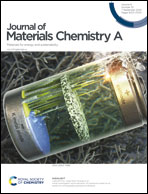Trimetal atoms confined in openly accessible nitrogen-doped carbon constructs for an efficient ORR†
Abstract
The electrochemical oxygen reduction reaction (ORR) is one of the key processes for various energy storage and conversion systems. To date, transition metal-based nitrogen–carbon systems (M/NC) have been demonstrated as promising low-cost catalysts. However, their low content of metals and the lack of coupling among multimetal atoms still affect the ORR kinetics. Herein, we develop a hierarchical N-doped carbon structure to house isolated trimetal (Co, Fe and Zn) atoms via pyrolysis of doped amorphous ZIF-90. Owing to the versatile compositional and structural design of its precursors, the resultant catalyst has a high metal loading (5.5 wt%) and a highly open structure with abundant mesopores, which significantly increase the population of effective active sites. Moreover, charge transfer among these three metals (Co, Fe and Zn) is found, which leads to the promotion of the oxidation state of Co species (primary active sites). Benefiting from the openly accessible active sites and the promotion effect, the catalyst exhibits remarkable ORR activity and stability, outperforming its bimetallic/single metal counterparts and commercial Pt/C.



 Please wait while we load your content...
Please wait while we load your content...